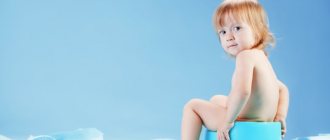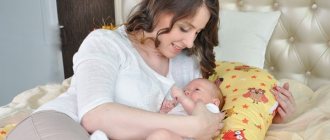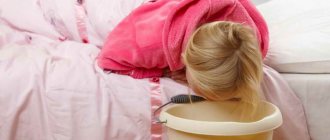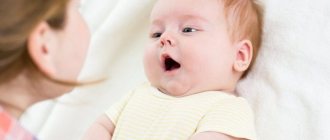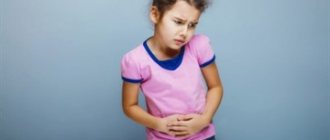Children who have changed their status from infants to the proud title of preschool children are very vulnerable to diseases of the digestive system. Food becomes varied and not always healthy. Active socialization (attending kindergarten, crowded social events) significantly expands the child’s social circle. The number of contacts with carriers of various infections is increasing. The baby learns about the world around him and puts everything into his mouth. A complex of predisposing factors creates favorable conditions for frequent diarrhea in a 2-year-old child.
Causes and symptoms
Often the cause of diarrhea in children of the second or third year of life is the penetration of an infection: bacterial or viral. In this case, in addition to repeated loose stools, the child may experience fever, general weakness, nausea, and vomiting.
Babies may refuse to eat and have trouble sleeping, but the main problem is the threat of dehydration. Therefore, if a 1-2 year old child begins to have diarrhea, regardless of the cause, it is important to ensure that he drinks as much fluid as possible.
It often happens that diarrhea in children occurs after taking certain medications, such as antibiotics. It is not worth trying to treat such an ailment in children on your own using various means; in this case, you should consult a doctor who will tell you to prescribe medications that prevent the development of dysbiosis.
Diarrhea in children 1-2 years old while taking antibiotics can be accompanied by fever and become chronic, when loose stools last longer than 2-3 weeks and occur more than 4-5 times a day. Therefore, it is very important not to delay time, but to immediately contact a pediatrician.
Often, diarrhea in children of the second year of life can be accompanied by vomiting and high fever, being a symptom of a disease, for example, dysentery. If such signs are present, you should immediately consult a doctor for diagnosis and timely initiation of adequate therapy.
Diarrhea in children 2 years old can also be functional. Only a doctor can recognize this disease, since parents often do not pay attention to their child’s loose stools if there are no other symptoms. With a functional disorder, the general condition of the body is not disturbed, the physical development of the baby does not slow down, and weight gain is only slightly reduced.
To identify this type of disorder, you need to take tests and undergo an examination by a doctor, who, based on the results of the study, will tell you which remedy should be given to the child. It is important to remember that you cannot prescribe medications to a 2-year-old child on your own, since self-medication of any childhood diseases can cause many serious consequences.
Most often, when diagnosing children in their second or third year of life, the cause of diarrhea is determined to be a bacterial infection. At this age, children begin to attend kindergarten, where the prescribed sanitary standards are not always observed.
The causative agents of the disease are Salmonella or Flexner bacteria, as well as a variety of pathogenic E. coli (Staphylococcus aureus, Campylobacter). In this case, it is important to correctly and quickly identify the specific pathogen, since Flexner bacteria cause dysentery, and Staphylococcus aureus causes a toxic infection of the housing and communal services in children 2-3 years old.
The cause of infection can be stale food , spoiled fruits and vegetables, unwashed hands, direct contact of the baby with other children in kindergarten if they already have such infection (any type of bacterial infection). What remedy to give the baby in this case can only be decided by a pediatrician, after the causative agent has been identified.
Viral infection is another common cause of diarrhea in children, accompanied by deterioration in general condition, weakness, and vomiting; Fever, nausea, and dizziness are often observed.
Laboratory tests often reveal rotavirus infection, which can occur in the form of gastroenteritis. The disease can occur not only in children 2-3 years of age and older, but also in babies under one year old. This type of diarrhea is very severe, often causing severe dehydration, so it is important to take timely measures to prevent this condition.
What to do in this case?
In order to stop vomiting, you need to give sorbents:
- "Enterosgel";
- "Smectu";
- Activated carbon.
To reduce the temperature, the child needs to be undressed and rubbed with a vinegar solution. The product is prepared quickly. Mix 50 ml of warm boiled water and 30 ml of table vinegar. This composition will quickly help reduce the temperature. After this, the child should be hospitalized.
These symptoms appear when:
— rotavirus infection;
- food poisoning;
- viral hepatitis.
Signs of dehydration
If your baby has frequent loose stools, accompanied by high fever and vomiting, it is important to monitor the baby’s condition and promptly replenish fluid levels in the body to prevent dehydration. Children are much more susceptible to this condition than adults because:
- the body contains more water;
- water-electrolyte exchange proceeds much faster;
- The neurohumoral and renal mechanisms of children in the second or third year of life are not yet perfect, and therefore cannot independently regulate the balance in the body during the period of illness.
Symptoms of dehydration in children with diarrhea should be distinguished, since in some cases you can cope on your own, but sometimes an urgent call to the doctor is required, since dehydration is dangerous for a weak child’s body.
Symptoms that you can cope with yourself:
- severe dryness of the skin, mucous membranes of the mouth and tongue;
- presence of viscous saliva;
- grayish skin tone;
- drowsiness and weakness;
- crying without tears, frequent restlessness of the baby;
- rapid pulse;
- retraction of the fontanel (in babies under one year);
- infrequent urination with small amounts of dark-colored urine;
- sunken eyes;
- constant thirst.
Symptoms that require immediate medical attention:
- constant crying of the child without tears;
- severe drowsiness;
- weight loss;
- cramps and muscle spasms;
- violation of skin turgor;
- marbled skin color;
- cooling of the extremities;
- severe sunken eyes;
- refusal to drink.
The degree of dehydration in children can vary:
- about a mild degree if the fluid loss is no more than 5%. This condition usually occurs at the onset of acute diarrhea with vomiting.
- The average degree is observed when the normal water volume of the child’s body decreases by about 10%. The condition occurs upon the onset of the second day from the appearance of loose stools, and may be accompanied by refusal to drink and hyperthermia.
- Severe dehydration indicates that the body has lost more than 10% of fluid. The condition appears against the background of severe diarrhea with incessant vomiting.
When vomiting
Valerian root tea can help with vomiting. Pour hot water over a teaspoon of the plant and cook over low heat for 10 minutes. Then take a tablespoon three times a day.
A decoction of herbs: chamomile, lemon balm and peppermint. To prepare the product, take all the ingredients in equal parts and mix. Infuse a tablespoon of the mixture in a glass of boiling water. Then give the child a tablespoon three times a day.
A decoction or compote of rose hips helps restore water balance.
Also, when vomiting, it is necessary to give the child a saline solution. This will help avoid dehydration.
Drugs that can be given to a child when vomiting:
- "Smecta", "Absorbent";
- "Enterofuril" is an antibiotic that destroys almost all intestinal and vomiting pathogens;
- "Mezim forte." Can be prescribed by a doctor for intestinal infections;
- "Motilium". Prescribed to relieve severe vomiting in children;
- "Lactofiltrum". The drug removes pathogenic bacteria from the body, improves intestinal microflora, and is prescribed for food poisoning, allergies, and dysbacteriosis;
- "Creon 10000". The drug is similar to Mezim, but more effective;
- "Primadophylus" is a dietary supplement containing bifidobacteria. Designed to improve the condition of a child with food poisoning, diarrhea, dysbacteriosis.
How to reduce fever during vomiting and diarrhea? Wiping with a vinegar solution, alcohol solution,
Also, for vomiting and diarrhea, children 2 years old can be given Paracetamol with a quarter of an Analgin tablet.
What are the dangers of dehydration?
In this condition, brain nutrition and general blood circulation are disrupted, as well as the protective function of the blood-brain barrier. If dehydration persists for a long time or is repeated frequently, the consequences may be the occurrence of diseases such as Alzheimer's or Parkinson's disease, multiple sclerosis, and obesity.
When dehydrated, blood thickens greatly, becomes viscous, and the lumens of blood vessels decrease, which increases the risk of blood clots. Often the result of dehydration is immunodeficiency chronic diseases, for example, scleroderma or bronchial asthma.
Poisoning
If a child is 2 years old and has loose stools without fever some time after eating, this may be a sign of poisoning. Pay attention to what the baby ate shortly before his health deteriorated. In case of poisoning, you can often find pieces of undigested food in the stool. Vomiting may or may not be present. The child in this situation complains of abdominal pain. You can hear fermentation and gurgling. A distinctive feature is the fetid odor of feces.
In case of poisoning, severe intoxication occurs. The child's condition may become severe due to dehydration. If you see that your baby is getting worse, call an ambulance immediately. Often, the use of incompatible products results in mild poisoning.
How and what to feed your baby
If you have diarrhea, following a diet is important. The main point is the restoration of the lost water-salt balance, but nutrition also plays an important role.
In the first days of the disease, it is necessary to feed the baby about 6 times a day in small portions, but you should not do this forcibly. If the child’s condition is serious, then the size of the portions should be reduced by half, as well as the number of feedings, and meals should be fractional. Gradually (over a week) portions should be increased to normal volume.
The menu of a sick child should include vegetable soups with a mucous structure, cooked with the addition of cereals (buckwheat, rice or oatmeal), as well as liquid boiled non-dairy porridge. Jelly and compotes made from berries, especially blueberries, will be very useful.
From the very beginning of the disease, it is necessary to include fresh fermented milk products with bifidobacteria in the baby’s diet. Their fat content should not exceed 2.5%. On the second day of diarrhea, the child can be given crackers, and on the third day, low-fat cottage cheese and banana puree.
Baked apples are useful in this condition, since they contain substances that help the rapid restoration of mucous membranes, as well as normalize the intestinal microflora. Raw apples (mashed into puree) can be given only from 3-4 days. During the same period, you can include in the menu a steamed omelet, meat purees from lean chicken, turkey or veal, as well as steamed meatballs, cutlets or meatballs.
It is important to completely exclude fresh fruits and vegetables, milk, mushrooms, juices, fermented baked milk, cream, legumes, confectionery, rye bread and baked goods, as well as carbonated drinks from the baby’s diet.
Sugar consumption should also be limited. You should not give fried, pickled or smoked foods, or prepare soups with strong meat or vegetable broths. It is also important to observe the temperature regime of food: dishes should be warm, since hot or cold foods will further irritate the mucous membrane.
After the diarrhea stops, the diet must be followed for about 2 more weeks, but the doctor will tell you the exact period based on the cause of the disease and the severity of its course.
Author: Vaganova Irina Stanislavovna, doctor
Treatment of diarrhea in a two-year-old child
Treatment of diarrhea in a child aged 2 years begins with identifying the cause of the digestive disorder. If poisoning is clearly visible, you need to drink boiled water and induce vomiting by pressing on the root of the tongue until the stomach is completely cleansed. For any etiology of diarrhea, replenish fluid loss with plenty of warm drink. This is weak sweet tea, dried apple compote, rosehip infusion, or just boiled water. You can give your child regdrants from the pharmacy.
Fixative medications that can stop diarrhea are Smecta powder and activated charcoal. Sometimes it is worth using folk remedies - rice broth, as well as decoctions of pomegranate peels and St. John's wort. When using herbal remedies, be careful because of possible allergies in your child. A decoction of St. John's wort increases skin sensitivity to the sun; fair-skinned children experience sunburn.
An important step on the path to recovery will be a diet that is gentle on the stomach and intestines for babies. The first step is to exclude intolerable foods that cause diarrhea. They can be fruits, fresh milk, and vegetables that may seem healthy at first glance. Digestive enzymes are present in the baby in insufficient quantities, so not all food is digested. Feed your child rice, semolina, and buckwheat porridge with water. Let's have some boiled, baked potatoes. Protein products include steamed omelette, lean boiled chicken without skin. During diarrhea, fresh fruits, vegetables and juices are prohibited. Avoid milk and milk products for now. Of course, no sweets, snacks, soda, sausages, or fast food. Pamper your child with dry, inconvenient cookies and biscuits.
Taking antibiotics
If the child is 2 years old, loose stools with mucus may result from drug treatment. This condition is often provoked by antibacterial drugs. Remember if you gave these to your baby the day before. It often happens that a child has a disease, for example, bronchitis or tonsillitis. The doctor prescribes an antibiotic, after which diarrhea begins within a few days. This is a completely normal reaction. The fact is that drugs with a wide spectrum of action destroy not only pathogenic flora, they kill beneficial microorganisms. Because of this, digestive failure occurs, accompanied by fermentation, bloating and loose stools.

